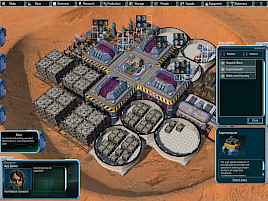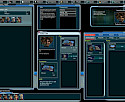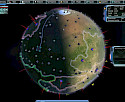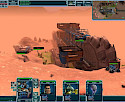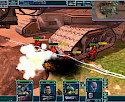UFO Afterlight Preview
I recently went to the Czech Republic, and while there I had a chance to play with the upcoming UFO: Afterlight. The game takes place on Mars, and the few humans that go there are on a mission to terraform the planet into a suitable environment for our species.
Strategic game
The interface has changed substantially from Aftershock. You now have only one base, and have to assign specific people to the many buildings. Some of your people will have skills in Soldiering, Engineering or Science only, while others have combinations. Certain tactical missions require you to bring at least one engineer, as you need to repair something on site for instance. After succeeding the mission the engineer gain engineering experience in addition to combat.
This brings a nice new addition to the gameplay, as you always have to consider the risk. Bringing a skilled engineer to a mission may be required, but if he is hurt or die you may have a serious setback in production. The fact that you only have a small pool of people to use this time further complicates matters, and you will have to make careful choices as you play. I do not know if bringing an experienced engineer to a mission has any advantages over bringing a rookie, but I certainly hope so.
The small pool of people available also puts a stronger focus on the RPG elements of the game. All people, be it engineers or soldiers, now have background stories and unique voices. Some voices do a very good job of reflecting the personality, while others made me want to friendly fire immediately! All in all the voices were good however.
Training also has a broader spectrum now. In addition to soldier training there is also engineer and scientist training. This will help differentiate your people further, and make some people invaluable for certain types of research or manufacturing.
The negative side to this is that you have to guard your people carefully. Any skilled commander will do his best not to lose troops of course, but having so few available as you do in Afterlight might restrict some styles of play. Many hardcore strategy fans like to play games in “Ironman mode”, never saving unless it’s to end the game session, and that might be hard to do with the few people you have available in Afterlight.
Research and manufacture works pretty much the same way it did in Aftershock. You choose what project to work on, and can queue them to make sure your people never rest. Different from Aftershock is the fact that you use specific people for the projects as mentioned above, and that the research tree seems like it has been branched more. As I started my research two of my scientists debated whether it would be better investigating the earth weapons or a new technology like laser weapons. I think ALTAR mentioned that you can’t expect to finish all research in Afterlight, and that is a good thing for replayability.
Soldier management seems a little odd in this installment. There are separate screens for training, assigning squads and equipping the troops. What’s the point of that? I suppose it was done to make things tidy, but I really felt it only made a mess. When I was in the squad screen I kept trying to right click the soldier portrait to see his equipment. This is what you do in the tactical portion of the game, and I really feel it should be consistent. There were also other small things that bugged me with the new interface.
As for the diplomacy screen, I didn’t play the game long enough to need it. I’m not sure what changes ALTAR have made to diplomacy in Afterlight, but I believe the plan was to expand it over the very limited uses it had in Aftershock.
The storage screen lets you manage all sorts of equipment you have in stock. I was happy to notice a “Dispose of” option there now, so you don’t need to fill up your stores with all sorts of junk. I don’t know if there are any limitations to how much you can store, but I certainly hope so. That’s the sort of thing that adds another small nifty part to the strategic gameplay.
Resources are done a little differently in this incarnation. There are actually more of them than in Aftershock, but the way they function has been simplified somewhat. There are no specific numbers of resources you require to construct a building, but a level of resource income. Barracks might require low level of one resource and medium of another for instance. You get resources from mines you build on the Mars surface, and the more you have the higher your level of resource income.
Finding out where my troops were and what they were doing was a little troublesome. This is something ALTAR is working on however, and will therefore hopefully be better in the final version of the game. At present I was always wondering whether my men were in training, working on a project, away in the Mars vehicle or lost in space. The information was available if you looked around, but it wasn’t very intuitive.
Tactical game
The graphics engine has stayed pretty much the same since Aftershock. They have added support for multiple resolutions and some other tweaks, but nothing major. The art direction is radically different now however, and the overall quality of models and animations seemed better. The fresher colors and cartoony style might put off some fans, but personally I thought it looked very good. The setting is quite different from the post-apocalyptic atmosphere of Aftermath, and I think the new art direction is appropriate.
The interface has changed a little in the tactical portion of the game as well. If you bring only three people on the mission, only three portraits clutter the screen. There is a minimized box under each portrait showing the queued plans of the unit, and you can edit it as you like. There are little icons showing stance, movement speed and type of fire. All in all it was a little different from Aftershock, but nothing too substantial and most for the better.
The gameplay itself is quite similar to that of Aftershock. Friendly fire is substantially more harmful now. I think that’s a good thing, as it adds a little more realism, but I got to experience it the hard way! There is a stronger focus on the melee weapons now, and I think anyone fond of such should have a blast with one of the starting weapons. Your mobility depends strongly on what you wear now. In the beginning you only have the standard space suit, and it limits your movement options significantly. You can’t run with it on, and you can’t kneel or prone. You’ll be able to do so with later gear, but the first suits aren’t very good.
The missions I played were fewer than in Aftershock, but lacked variation. This was a problem of Aftershock, but when I asked ALTAR they told me there is a much larger variation to missions this time. Problem was that I was playing an early version that wasn’t balanced, and thus got a lot of very similar beginner missions.
The AI is partially scripted now. It seemed better, with enemies retreating to regroup, but I only met one type of enemy and had too little variation in missions to properly judge. ALTAR is well aware of the fans eagerness for good AI however, so I believe they will make it a priority in the later stages of development.
Impression so far
I played the game way too briefly to conclude one way or another. In addition it wasn’t finished, with many issues still to be solved. That being said, I’ll share my first impression with you. The game seems well on its way to a polished title, and I think ALTAR is in control this time. I had some issues with the strategic interface, but with some tweaks and improvements that can be solved.
The AI seems to be on the right track, and fewer tactical missions with a greater variation will be good! I think more time will be spent in the strategic view this time, and your choices and actions should have stronger consequences. I didn’t take notice one way or another with the background music, and I guess that means it’s doing well.
If ALTAR can manage to put players in the right mood with the Mars atmosphere, and challenge players with decent AI, I think Afterlight might be a superb game. My hands-on wasn’t enough to make me decide one way or another however, so you’ll have to wait for release to get the answer. Definitively a game to keep a watchful eye on however!


